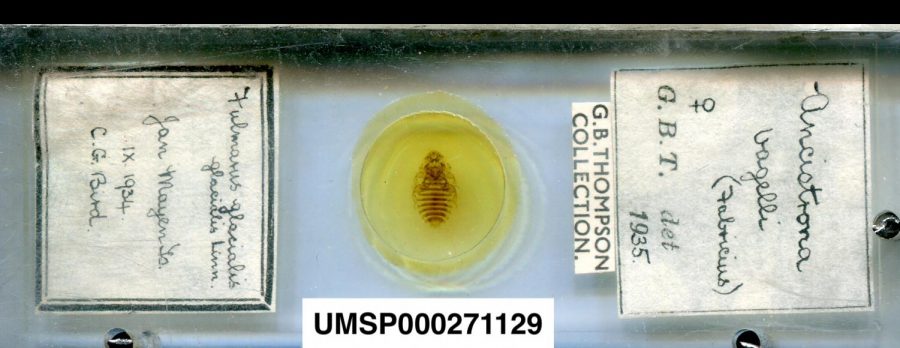Walking through the University of Minnesota Insect Collection, curator Robin Thomson pulls a series of cases from one of dozens of shelves lining the storage facility. Opening it up, she pulls out a glass slide, pointing to a small louse pressed up against a flat surface.
As one of 28 universities and museums part of a national project called the Terrestrial Parasite Tracker, the University is working to digitize parasite data in order to make it more accessible to researchers around the world.
Uploading photos and transcribing data for terrestrial parasites like lice, fleas, ticks, mites and various groups of biting flies, a group of curators and bug enthusiasts around the country are compiling data in ways they have not been able to before. Some of the data they collect includes the location where the insect was found, its scientific name and the name of the person who found it.
Thomson said it is sometimes challenging to share insect information with researchers out of state. If a researcher in Arizona, for instance, wanted to access a type of louse in the collection, she would have to mail the specimens to them directly or type up the data needed and send it back.
“It’s kind of physically inaccessible,” she said. “So the idea is to take all of this data sitting in these collections, and somehow get it online and available to the public and to general researchers.”
The University is compiling images and data for all of the fleas and lice in its collection, which includes over 8,000 specimens of fleas, 14,000 specimens of sucking lice and 242,000 specimens of chewing lice.
Through this work, researchers will be able to better understand the evolution of the parasites’ behaviors and health challenges they cause, said Jennifer Zaspel, the director of the project and a research curator at the Milwaukee Public Museum.
“These collections are libraries of life on our planet, and represent those organisms where they have occurred over long periods of time,” Zaspel said.
Digitizing these collections allows researchers to access information about when, where and what organisms were collected over the past 100 years, Zaspel said. Such baseline data can help them better understand environmental change, habitat loss, pollinator distribution and invasive species, she said.
Zaspel said there are numerous challenges involved with documenting these collections. Many insects are stored in different locations inside museums or universities. They are also stored differently depending on size and anatomy, sometimes pinned, put in vials or placed on microscope slides, which can also pose a challenge for photographing the specimens, she said.
“We’re going to have to deal with hosts and parasites, and understanding those kinds of evolutionary dynamics will help us deal with them in the future,” said Sarah Bush, an associate professor at the University of Utah who is also involved with the project. “Getting this data is a good solid foundation to start.”
All of this work is done by hand, and with COVID-19, the transition to working from home has been relatively well-suited for this work, she said. For the last eight months, Bush has been scanning specimens on her dining room table, with the help of her two 12-year-old sons.
Members of the public can also assist the team by interacting with the University’s Notes for Nature website, where they can view insects and transcribe handwritten labels from microscope slides that computers cannot interpret. Participants can identify lice from the University’s collection or fleas from Chicago’s Field Museum.
“We’re using volunteers to help get this information, and that is really fun because they see things from places all over the world,” Bush said. “Sometimes they’re from an albatross collected … just after World War II, or sometimes it’s something that was collected last year. We have some specimens that were from 1850. So it’s kind of a nice window into museums that most people don’t get to see.”














